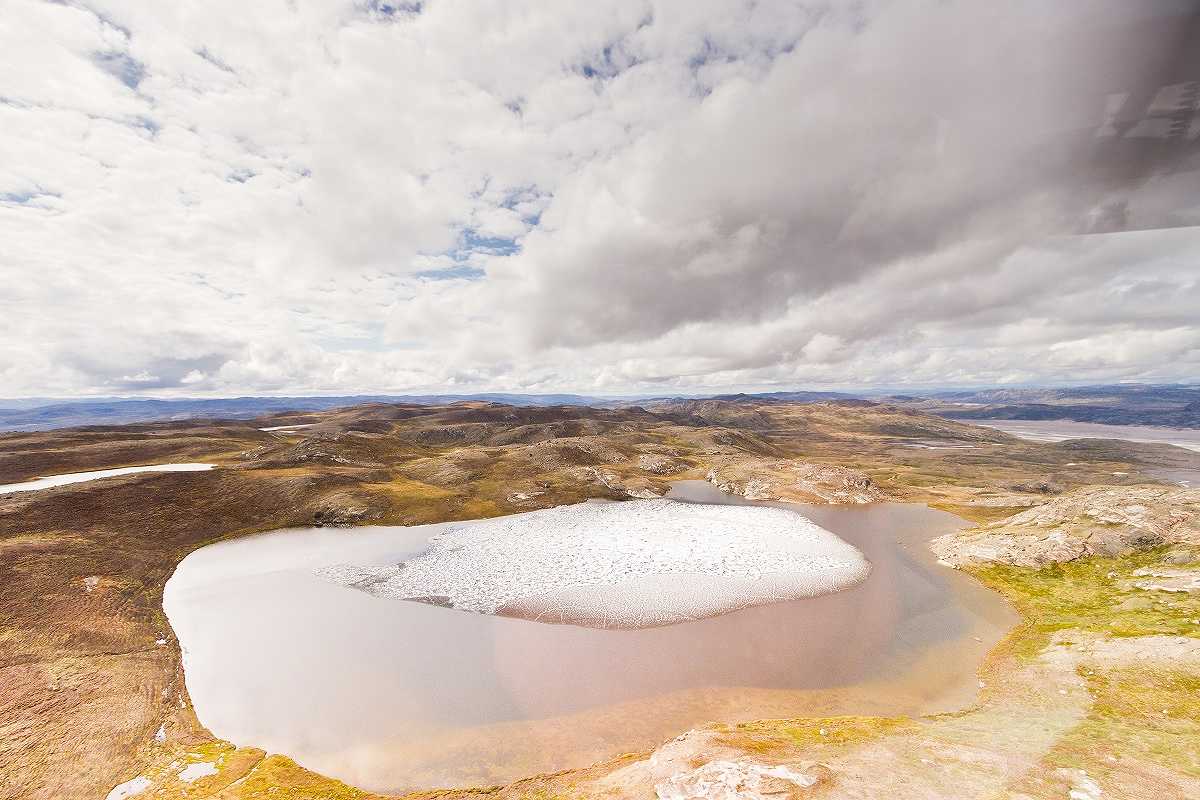Ancient Soil Shows Part of Greenland Was Ice-Free – and Could Soon Melt Again, Scientists Say

Melting ice on a small Greenland tundra pond.
11:54 JST, July 21, 2023
As soon as Andrew Christ peered at the sample inside his microscope, he knew he had found something special. Bits of tiny twigs, moss and leaves were mixed with sediments extracted from deep beneath a Cold War military facility on the Greenland ice sheet. It was as if he’d opened a time capsule from the deep past – revealing proof that a tundra ecosystem once flourished where there is now nearly a mile of ice.
But it wasn’t until years later, after Christ and his colleagues figured out the age of those samples, that he fully grasped the importance of the discovery. New analysis suggests that the material comes from a period about 416,000 years ago, when Earth’s temperature wasn’t much higher than it is now. The results mean that Greenland once lost a tremendous amount of ice under climate conditions very much like the ones humans have created and are currently living in. They imply that coastlines could soon be submerged under several feet of sea level rise – unless people manage to stop emitting greenhouse gases and reverse the dangerous warming of the world.
“If the Greenland ice sheet could melt substantially in the past, it is going to change our projections for the future,” said Christ, a postdoctoral researcher at the University of Vermont. “It could have a financial cost as well as a massive humanitarian cost.”
The findings published Thursday in the journal Science add to a growing body of research exposing Greenland’s vulnerability to even moderate amounts of warming. Other studies – including a preliminary analysis of Christ’s Cold War sediments published in 2021 – have showed that the ice sheet nearly vanished at least once in the past million years.
But knowing exactly when parts of Greenland were last uncovered is crucial to understand the fate of the ice sheet today, Christ said.
For the past 2.4 million years, the climate has shifted back and forth between frigid ice ages and warmer phases known as interglacials. Unlike today’s warming, which is caused by the rapid release of planet-warming pollution from burning fossil fuels, those ancient fluctuations in the planet’s temperature were triggered by slight changes in the Earth’s orbit. Depending on the way the planet wobbled as it circled the sun, an interglacial might be hot and brief, or longer and milder.
The interglacial that occurred between 426,000 and 396,000 years ago, which is known to scientists by the unwieldy name “Marine Isotope Stage 11,” was of the long and mild variety. If plants were growing in northwest Greenland back then – as the new Science study suggests – the same could happen during a future stretch of prolonged warm conditions.
Prolonged warming is exactly what humans are causing now, Christ said. The carbon dioxide released by people driving cars, burning fuel and destroying natural ecosystems will linger in the atmosphere for thousands of years. And without a drastic shift in the way we live, humanity is on track push global average temperatures to 3 degrees Celsius (5.4 degrees Fahrenheit) above preindustrial levels by the end of this century, according to the Intergovernmental Panel on Climate Change. That is well above the highest temperatures reached during Marine Isotope Stage 11.
Study co-author Paul Bierman, a geologist at the University of Vermont, called the implications “frightening.” When the researchers calculated how much the Greenland ice sheet would have to shrink to allow plants to grow in that particular corner of the island, they found it could lead to between 4.5 and 18 feet of sea level rise.
“If you look at where sea level was 400,000 years ago, and where humans are today, a huge number of the Earth’s population lives within that distance of sea level,” Bierman said. “It really implies that we’ve got to turn around this trajectory of pumping carbon into the atmosphere or we’re going to trigger things that are irreversible on a human time scale and grossly damaging to our planet and our people.”
Despite the sediments’ scary message, Bierman says scientists are lucky to have them. It takes so long to drill through ice that very little material has ever been uncovered from beneath the ice sheet. If not for a decades-old military boondoggle, these particular samples wouldn’t exist at all.
More than 60 years ago, amid ratcheting Cold War tensions, the United States began to dig a military base beneath the surface of the Greenland ice sheet. In public, officials claimed “Camp Century” was merely a research facility, and they invited scientists to conduct experiments at the remote location in northwest Greenland. But privately, the U.S. Army was planning “Project Iceworm” – a top-secret initiative to hide dozens of soldiers and potentially hundreds of weapons in a network of tunnels under the ice.
It didn’t take long for the motion of the ice sheet – which is constantly flowing under the pressure of its own weight – to expose the folly of this scheme. Tunnels collapsed, equipment malfunctioned and the encampment was eventually abandoned. Thousands of tons of building materials, unused diesel fuel and radioactive waste were left to languish under the ice.
The project did yield one breakthrough. To lend credibility to the camp’s scientific cover story, experts spent three years drilling a first-of-its-kind ice core at the site. Encompassing nearly a mile of ice and some 10 feet of subglacial sediment, the core helped spark the rise of a whole new field of research on Earth’s climatic past. By studying tiny bubbles of oxygen trapped within layers of ice, scientists were able to create a timeline of the planet’s temperature going back tens of thousands of years.
Fewer people were interested in the dirt at the bottom of the core. Over the decades, as it was shuffled between freezer facilities in the United States and Denmark, scientists largely forgot the sample existed.
This was another stroke of luck, said Tammy Rittenour, a geoscientist at Utah State University and a co-author on the study. She specializes in a kind of analysis that uses light to determine how long a material has been hidden from the sun. When sediments are buried, they are exposed to constant, low-level bombardment of radiation from the surrounding soil. This causes tiny electrons to accumulate within the molecular framework of the minerals, the way dirt might accumulate in the weave of a shirt that was never washed.
Exposing the sediments to light is like dunking the shirt in bleach – the accumulated detritus of centuries is instantly lost.
But by the time the Camp Century sediments were rediscovered in a freezer at the University of Copenhagen, it was clear no one had touched the sample in decades. Working in darkroom conditions, scientists were able to carefully carve out slices for Rittenour to analyze.
At her lab, Rittenour melted the frozen sediment and sieved it to extract individual grains of the mineral feldspar. Next, she used a beam of light to “stimulate” the electrons that had long been trapped inside the minerals. By observing how the material reacted, she could calculate how much radiation it experienced during its burial, which in turn would indicate when the sediments last saw daylight.
Rittenour repeated the experiment roughly 100 times, and each go-round yielded the same estimated age: about 416,000 years, smack in the middle of Marine Isotope Stage 11.
“It’s the history of the Earth,” Rittenour said, “written in a grain of sand.”
Nicolás Young, a geologist and Arctic researcher at the Lamont-Doherty Earth Observatory at Columbia University who was not involved in the new study, said the findings offer important insight into the state of the Greenland ice sheet during Marine Isotope Stage 11. But they can’t be completely definitive about where the island was ice-free, he said, because of the way sediments move around.
“They collected them at the Camp Century site, but they likely weren’t always resting at the Camp Century site,” Young said. “That introduces some uncertainty.”
Yet Rittenour said it’s unlikely the sediments were found far from their original source. The fragile fossilized mosses and leaves mixed in with the minerals would have been crushed if they’d been plowed by a glacier or carried by a roaring river for hundreds of miles.
Christ thought back to the people who originally collected the Camp Century core more than half a century ago. They’d journeyed to the high Arctic amid fears of nuclear annihilation – never expecting they would uncover an entirely different existential threat.
To him, the story underscores the power of science.
"News Services" POPULAR ARTICLE
-

American Playwright Jeremy O. Harris Arrested in Japan on Alleged Drug Smuggling
-

Japan’s Nikkei Stock Average as JGB Yields, Yen Rise on Rate-Hike Bets
-

Japan’s Nikkei Stock Average Licks Wounds after Selloff Sparked by BOJ Hike Bets (UPDATE 1)
-

Japanese Bond Yields Zoom, Stocks Slide as Rate Hike Looms
-

Japan’s Nikkei Stock Average Buoyed by Stable Yen; SoftBank’s Slide Caps Gains (UPDATE 1)
JN ACCESS RANKING
-

Keidanren Chairman Yoshinobu Tsutsui Visits Kashiwazaki-Kariwa Nuclear Power Plant; Inspects New Emergency Safety System
-

Imports of Rare Earths from China Facing Delays, May Be Caused by Deterioration of Japan-China Relations
-

University of Tokyo Professor Discusses Japanese Economic Security in Interview Ahead of Forum
-

Japan Pulls out of Vietnam Nuclear Project, Complicating Hanoi’s Power Plans
-

Govt Aims to Expand NISA Program Lineup, Abolish Age Restriction






















